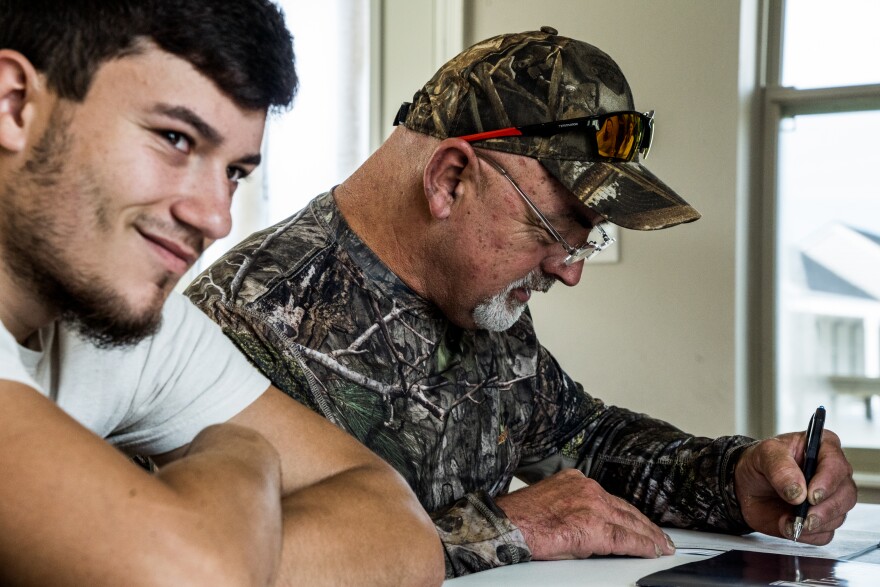After more than six years since receiving funding and construction marred with delays, less than half of the Isle de Jean Charles residents were finally allowed to move into their new homes Wednesday morning through the Isle de Jean Charles resettlement program, a project spurred by extreme land loss.
But the majority of the 37 households expected to take up space in the new subdivision, New Isle, will have to wait even longer after last-minute drainage concerns and unfinished construction.
The new subdivision is located on Bayou Blue Bypass Road in Gray, just 40 miles northwest of Isle de Jean Charles. The island used to encompass more than 22,000 acres, but over time has shrunk to 320 acres due to erosion and land loss caused by natural disasters and climate change. Many residents identify as low-income and Indigenous, and had to qualify for the housing by being current island residents or those who moved away after Hurricane Isaac in 2012 in order to get a house.
Governor John Bel Edwards was at the subdivision Wednesday, touring some of the completed homes and told a crowd gathered that this moment was bittersweet.
“But at the end of the day, this was the absolute best thing that we could do,” Edwards said. “This is the very first program of its kind in our nation's history, where we have basically had to move people because of climate change.”
Twelve of the 37 households were scheduled to move in Wednesday, with the other 25 moving in the coming months due to more construction needed at the site.
Funding for resettlement project happened in 2016 — four years after Isaac hit the area. Office of Community Development executive director Pat Forbes said that’s when $48.3 million was awarded to them because of their winning application from the federal National Disaster Resilience Competition. Of the $48 million, $11.7 million was used to purchase the 515-acre property in Gray, a site that was chosen by relocation participants because it was a higher, safer and in a more resilient location.

But the path to build the resettlement subdivision has been a difficult one, marked by construction delays, Hurricane Ida and a pandemic.
Previous reporting by WWNO said that construction was expected to be completed last spring, and the first set of expected move-ins earlier in August were also delayed due to drainage problems.
One attendee at the home closings, Chief Albert Naquin the Jean Charles Choctaw Nation, had been pushing for resettlement for the tribe — who make up the majority of the displaced Isle de Jean Charles residents — long before the state got involved in their plans starting 2014.
The original vision of the tribe's resettlement was reunification of tribal citizens, who have been displaced from storms, in one place so they could maintain their cultural heritage.
After the resettlement project secured funding through the tribe working with the Lowlander Center, a non-profit organization and with the Office of Community Development, the scope of the eligibility shifted from being a tribal citizen to when and where a resident lived in Isle de Jean Charles.
These changes in vision caused tribal leadership and the Lowlander Center to withdraw from their partnership although the work came originally from the tribe. In 2019, some of these frustrations played out publicly in various meetings.
Accusations of the state taking over the project and excluding tribal leadership were investigated by outlets such as USAToday and The Center for Public Integrity.
It was also documented in an academic study published in May by Nathan Jessee, a postdoctoral research associate at Princeton University's High Meadows Environmental Institute, who researches displacement and resettlement in coastal Louisiana and has covered this project for years.
The investigations noted gaps in communication and how the planning process unfolded between federal, state, local officials, tribal leaders and nonprofits. Specifically, changes to the original vision and the clause to be able to get a house on the new subdivision has left many tribal citizens unable to qualify for a home.

At Naquin’s visit to the subdivision, he noted his disappointment in the lack of completed construction on the houses, lack of copies of homeowner documents for the residents and drainage issues.
“In my opinion, this is the first move the people will make; hopefully the original plan and vision will happen sometime in the future, where the tribe will come together in a community that will unite them once again,” he said.
The Jean Charles Choctaw Nation also released a statement Wednesday that they supported their individual citizens’ choice to resettle through the program, but tribal members expressed concerns over the lack of consultation and buy-in from tribal leadership.
On Wednesday, the residents felt a mix of excitement, uncertainty, worry and relief.
The first house closing came from Isle de Jean Charles resident Chris Brunet. He said that this was the first time he has dealt with this level of paperwork to own a home.
“It’s the first time in my life to sign something with a lot of regulations and restrictions to live in this house,” Brunet said.
After the signing, his home was then “smudged” — a ceremonial burning of sacred herbs to purify and cleanse a space — by Chief Naquin.
Brunet said the day felt less like a celebration and more like a choice he had to make due to land loss and climate change, something he’s felt since he saw the site for the first time back in April 2021.
A round of heavy rains hit the area during the move-in, which caused even more water to gather underneath the homes and illustrated drainage issues on the lots.

Terrebonne Planning and Zoning director Chris Pulaski said that since construction is still active, contractors are working through the construction punch list to make sure that all immediate concerns are addressed. Each yard still needs regrading, according to Pulaski, to make sure that water is properly draining from the lot.
“We’re hoping by late September, but there’s still 15 to 20 other houses in varying stages of construction,” Pulaski said.
The subdivision will eventually include two bayous running through the property, wetlands, walking trails, a pasture, market center, festival grounds, community center and more expected to be completed by the end of the year.
One resident, Father Roch Naquin, blessed the families moving in at the ceremony through prayer. He also brought a box of salt to sprinkle into his home, a tradition of his, to bring in good luck.
His niece, Cheryl Boquet, said that her uncle was eager to sign Wednesday after being without a house for so long. But she also noted that some resiliency pieces promised during the community meetings, such as solar panels and generators, didn’t come to fruition. Already chipping paint on the front porch step of the home’s exterior also caused her to have reservations.
“They've had so many disappointments, so many setbacks, and it's like, OK, why has this taken so long?” Boquet said.

However, the homes fared well after Hurricane Ida even when they weren’t completed. They were built to FORTIFIED construction standards, which is when homes are built with materials including roofing, doors and windows that can withstand over 150 mph winds.
As for Father Roch Naquin, he checked the keys to make sure that the locks worked for his new home and walked through the space noting what window blinds he would install and how the furniture would be placed.
“I’m kind of excited — a lot of wondering about what the future holds in the New Isle,” he said.







